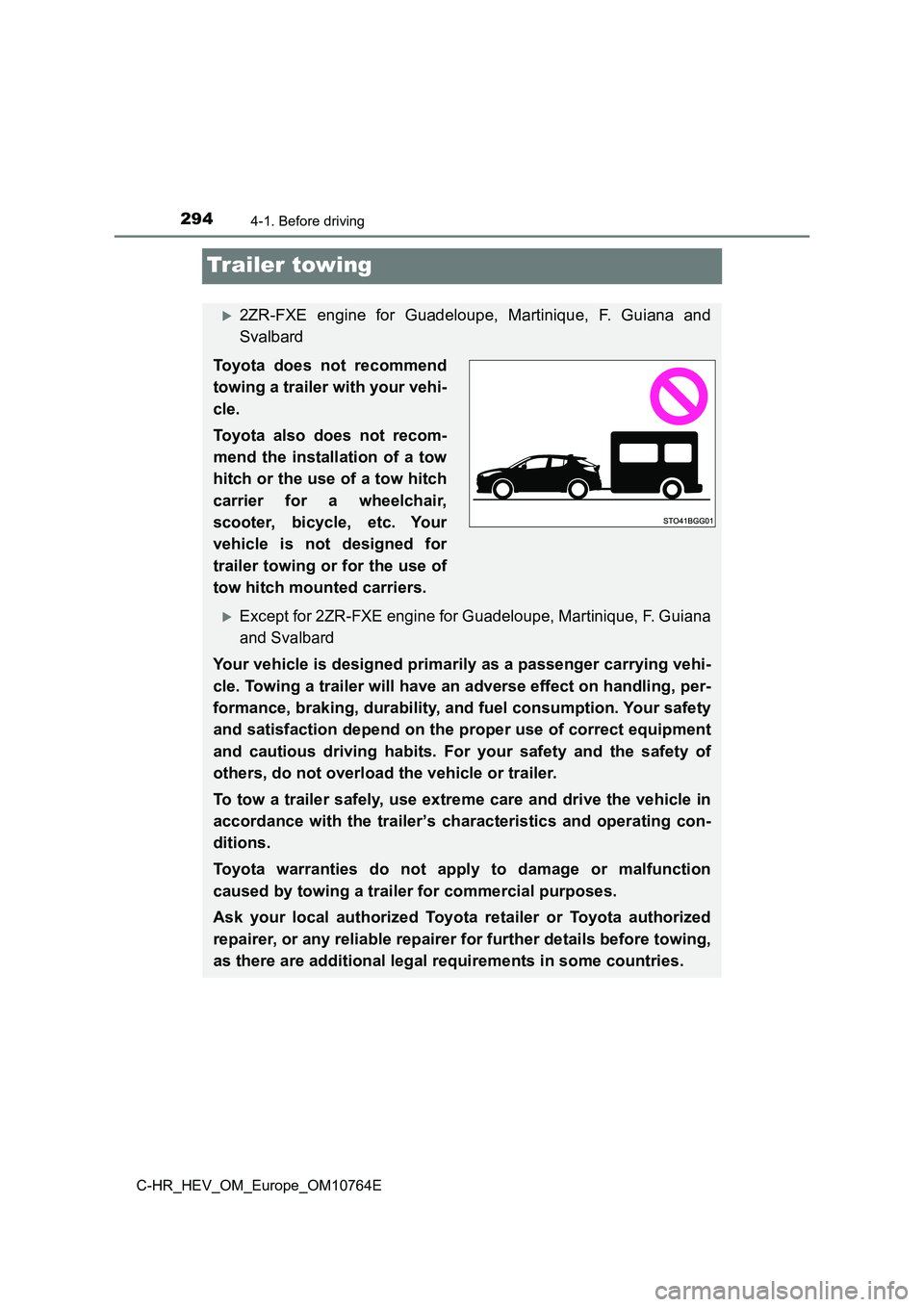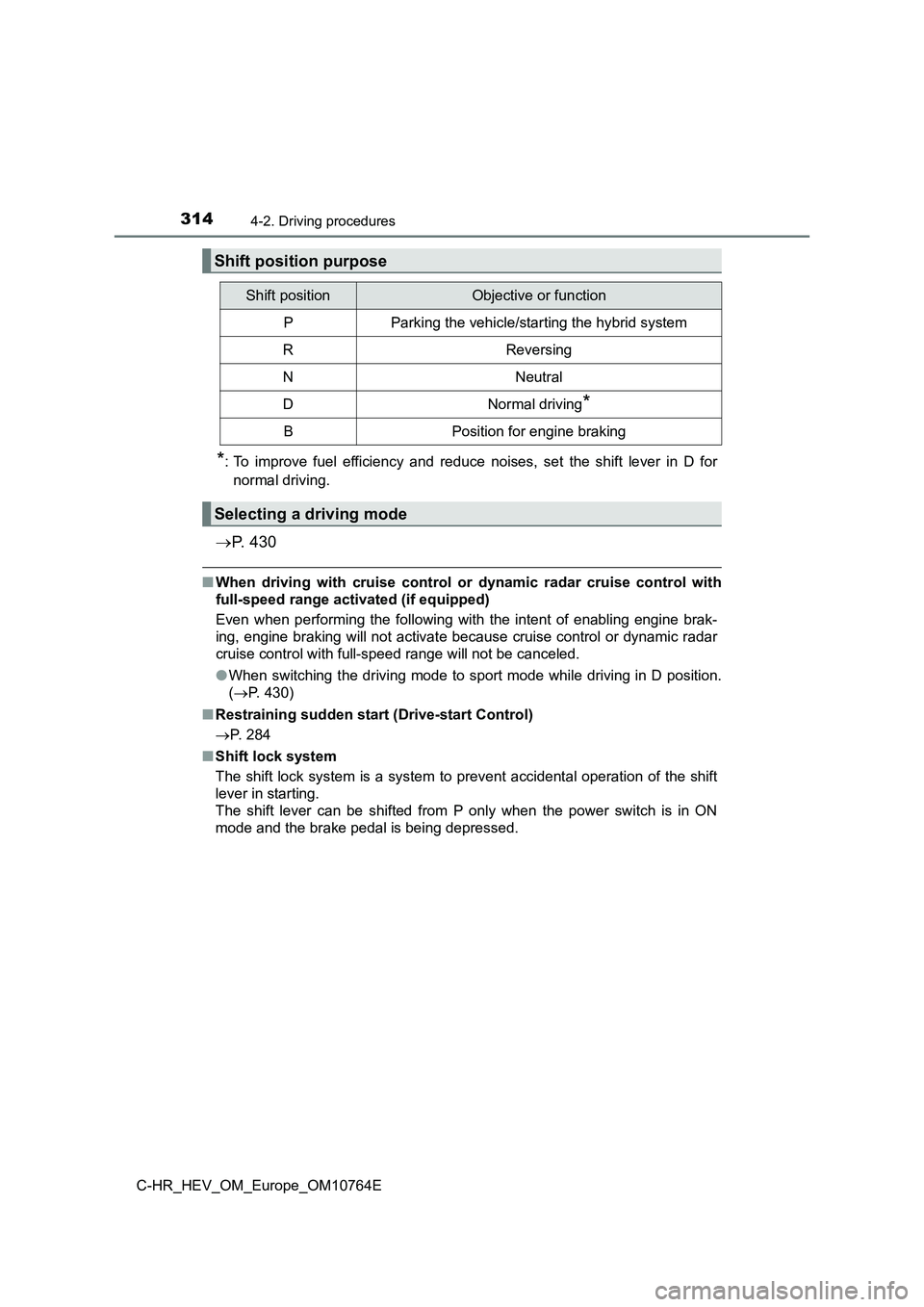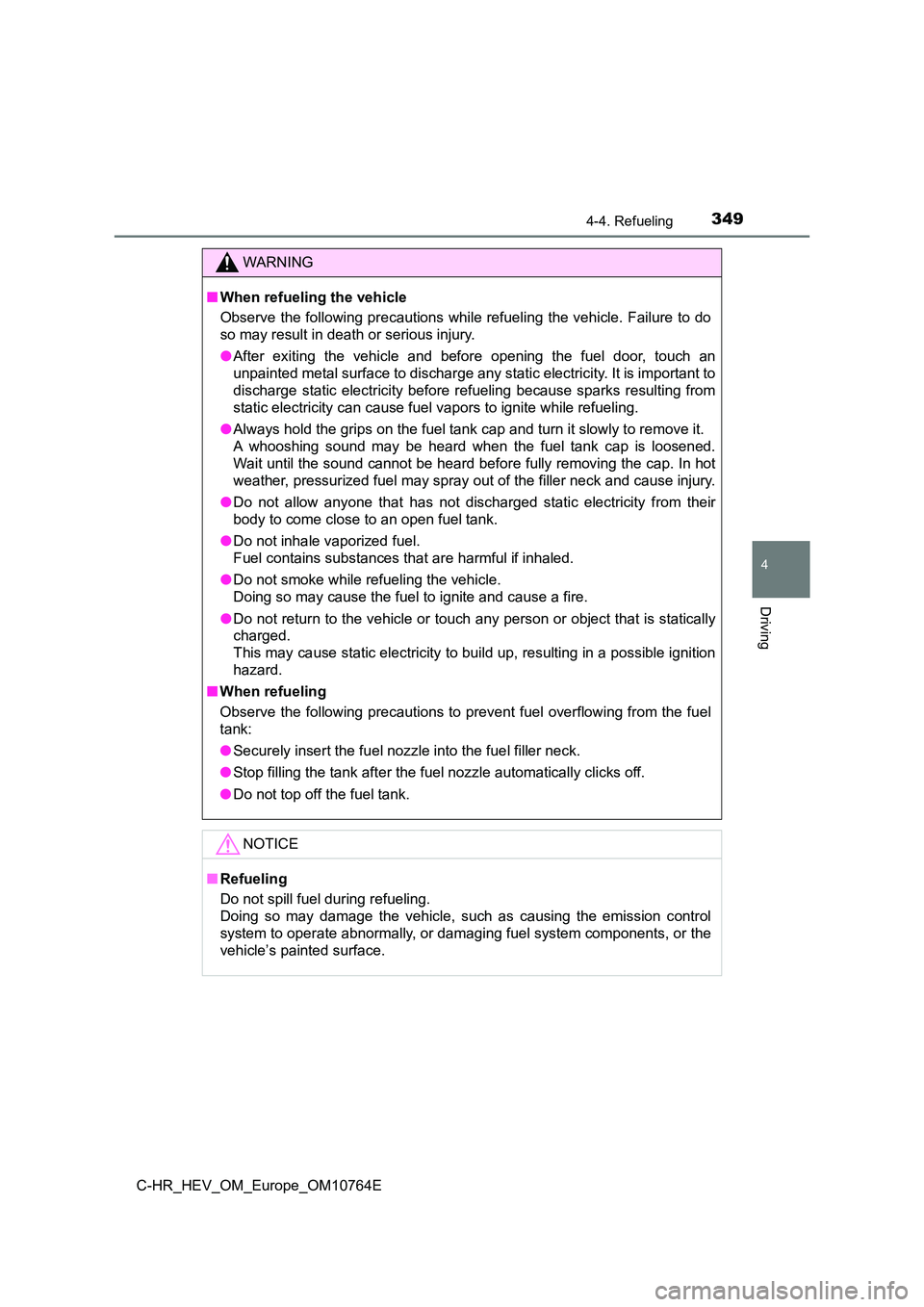Page 287 of 814
2854-1. Before driving
4
Driving
C-HR_HEV_OM_Europe_OM10764E
■ Breaking in your new Toyota
To extend the life of the vehicle, observing the following prec autions is recom-
mended:
● For the first 300 km (200 miles):
Avoid sudden stops.
● For the first 800 km (500 miles):
Do not tow a trailer.
● For the first 1600 km (1000 miles):
• Do not drive at extremely high speeds.
• Avoid sudden acceleration.
• Do not drive at a constant speed for extended periods.
■ Operating your vehicle in a foreign country
Comply with the relevant vehicle registration laws and confirm the availability
of the correct fuel. ( P. 767)
■ Eco-friendly driving
P. 166
WARNING
Observe the following precautions.
Failure to do so may result in death or serious injury.
■ When starting the vehicle
Always keep your foot on the brake pedal while stopped with the “READY”
indicator is illuminated. This prevents the vehicle from creepi ng.
Page 296 of 814

2944-1. Before driving
C-HR_HEV_OM_Europe_OM10764E
Trailer towing
2ZR-FXE engine for Guadeloupe, Martinique, F. Guiana and
Svalbard
Toyota does not recommend
towing a trailer with your vehi-
cle.
Toyota also does not recom-
mend the installation of a tow
hitch or the use of a tow hitch
carrier for a wheelchair,
scooter, bicycle, etc. Your
vehicle is not designed for
trailer towing or for the use of
tow hitch mounted carriers.
Except for 2ZR-FXE engine for Guadeloupe, Martinique, F. Guiana
and Svalbard
Your vehicle is designed primarily as a passenger carrying vehi -
cle. Towing a trailer will have an adverse effect on handling, per-
formance, braking, durability, and fuel consumption. Your safet y
and satisfaction depend on the proper use of correct equipment
and cautious driving habits. For your safety and the safety of
others, do not overload the vehicle or trailer.
To tow a trailer safely, use extreme care and drive the vehicle in
accordance with the trailer’s characteristics and operating con -
ditions.
Toyota warranties do not apply to damage or malfunction
caused by towing a trailer for commercial purposes.
Ask your local authorized Toyota retailer or Toyota authorized
repairer, or any reliable repairer for further details before t owing,
as there are additional legal requirements in some countries.
Page 314 of 814
3124-2. Driving procedures
C-HR_HEV_OM_Europe_OM10764E
■ Changing a driving mode when in EV drive mode
EV drive mode can be used in conjunction with “ECO” mode and “S PORT”
mode.
However, EV drive mode may be automatically canceled when used in con-
junction with “SPORT” mode.
■ Fuel economy
The hybrid system is designed to achieve the best possible fuel economy
during normal driving (using the gasoline engine and electric m otor [traction
motor]). Driving in EV drive mode more than necessary may lower fuel econ-
omy.
WARNING
■ Caution while driving
When driving in EV drive mode, pay special attention to the are a around the
vehicle. Because there is no engine noise, pedestrians, people riding bicy-
cles or other people and vehicles in the area may not be aware of the vehi-
cle starting off or approaching them, so take extra care while driving.
Therefore, take extra care while driving even if the acoustic v ehicle alerting
system is active.
Page 316 of 814

3144-2. Driving procedures
C-HR_HEV_OM_Europe_OM10764E
*: To improve fuel efficiency and reduce noises, set the shift lever in D for
normal driving.
P. 4 3 0
■When driving with cruise control or dynamic radar cruise control with
full-speed range acti vated (if equipped)
Even when performing the following with the intent of enabling engine brak-
ing, engine braking will not activate because cruise control or dynamic radar
cruise control with full-speed range will not be canceled.
● When switching the driving mode to sport mode while driving in D position.
( P. 430)
■ Restraining sudden start (Drive-start Control)
P. 284
■ Shift lock system
The shift lock system is a system to prevent accidental operati on of the shift
lever in starting.
The shift lever can be shifted from P only when the power switc h is in ON
mode and the brake pedal is being depressed.
Shift position purpose
Shift positionObjective or function
PParking the vehicle/starting the hybrid system
RReversing
NNeutral
DNormal driving*
BPosition for engine braking
Selecting a driving mode
Page 317 of 814

3154-2. Driving procedures
4
Driving
C-HR_HEV_OM_Europe_OM10764E
■ If the shift lever cannot be shifted from P
First, check whether the brake pedal is being depressed.
If the shift lever cannot be shifted with your foot on the brak e pedal while
pressing the button on the shift knob, there may be a problem w ith the shift
lock system. Have the vehicle inspected by any authorized Toyot a retailer or
Toyota authorized repairer, or any reliable repairer immediatel y.
The following steps may be used as an emergency measure to ensu re that
the shift lever can be shifted.
Releasing the shift lock:
Set the parking brake.
Turn the power switch off.
Depress the brake pedal.
■ About engine braking
When shift position B is selected, releasing the accelerator pe dal will apply
engine braking.
● When the vehicle is driven at high speeds, compared to ordinary gasoline-
fueled vehicles, the engine braki ng deceleration is felt less than that of other
vehicles.
● The vehicle can be accelerated even when shift position B is selected.
If the vehicle is driven continuously in the B position, fuel e fficiency will
become low. Usually, select the D position.
Remove the cover.
Remove the cover using flathead
screwdriver. To prevent damage to the
cover, tip the screwdriver with a rag.
Press the shift lock override button
while pressing the button on the shift
knob.
The shift lever can be shifted while the
button is pressed.
1
2
3
4
5
Page 320 of 814
3184-2. Driving procedures
C-HR_HEV_OM_Europe_OM10764E
*1: To improve fuel efficiency and reduce noises, set the shift lever in D for
normal driving.
*2: By selecting shift ranges using S mode, you can control accele rating force
and engine braking force.
P. 430
To enter S mode, shift the shift lever to S position. Shift ranges can be
selected by operating the shift lever.
Upshifting
Downshifting
The selected shift range, from S1
to S6, will be displayed on the
multi-information display.
The initial shift range in S mode is
4.
Shift position purpose
Shift positionObjective or function
PParking the vehicle/starting the hybrid system
RReversing
NNeutral
(Condition in which the power is not transmitted)
DNormal driving*1
SS mode driving*2 ( P. 318)
Selecting a driving mode
Selecting shift ranges in the S position
1
2
Page 350 of 814
3484-4. Refueling
C-HR_HEV_OM_Europe_OM10764E
Opening the fuel tank cap
●Turn the power switch off and ensure that all the doors and win-
dows are closed.
● Confirm the type of fuel.
■Fuel types
P. 777
■ Fuel tank opening for unleaded gasoline
To help prevent incorrect fueling, your vehicle has a fuel tank opening that
only accommodates the special nozzle on unleaded fuel pumps.
Perform the following steps to open the fuel tank cap:
Before refueling the vehicle
Page 351 of 814

3494-4. Refueling
4
Driving
C-HR_HEV_OM_Europe_OM10764E
WARNING
■When refueling the vehicle
Observe the following precautions while refueling the vehicle. Failure to do
so may result in death or serious injury.
● After exiting the vehicle and before opening the fuel door, touch an
unpainted metal surface to discharge any static electricity. It is important to
discharge static electricity before refueling because sparks re sulting from
static electricity can cause fuel vapors to ignite while refuel ing.
● Always hold the grips on the fuel tank cap and turn it slowly to remove it.
A whooshing sound may be heard when the fuel tank cap is loosen ed.
Wait until the sound cannot be heard before fully removing the cap. In hot
weather, pressurized fuel may spray out of the filler neck and cause injury.
● Do not allow anyone that has not discharged static electricity from their
body to come close to an open fuel tank.
● Do not inhale vaporized fuel.
Fuel contains substances that are harmful if inhaled.
● Do not smoke while refueling the vehicle.
Doing so may cause the fuel to ignite and cause a fire.
● Do not return to the vehicle or touch any person or object that is statically
charged.
This may cause static electricity to build up, resulting in a p ossible ignition
hazard.
■ When refueling
Observe the following precautions to prevent fuel overflowing f rom the fuel
tank:
● Securely insert the fuel nozzle into the fuel filler neck.
● Stop filling the tank after the fuel nozzle automatically clicks off.
● Do not top off the fuel tank.
NOTICE
■Refueling
Do not spill fuel during refueling.
Doing so may damage the vehicle, such as causing the emission c ontrol
system to operate abnormally, or damaging fuel system component s, or the
vehicle’s painted surface.